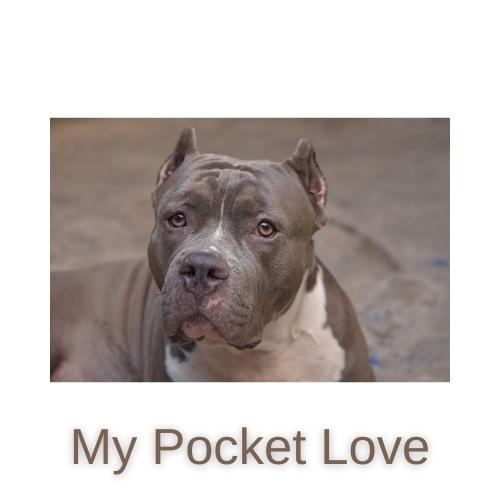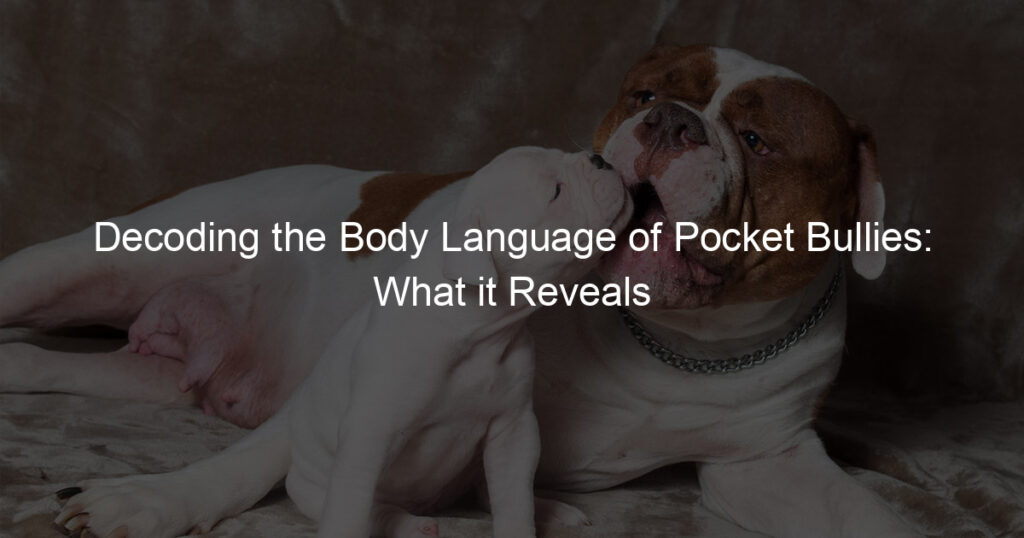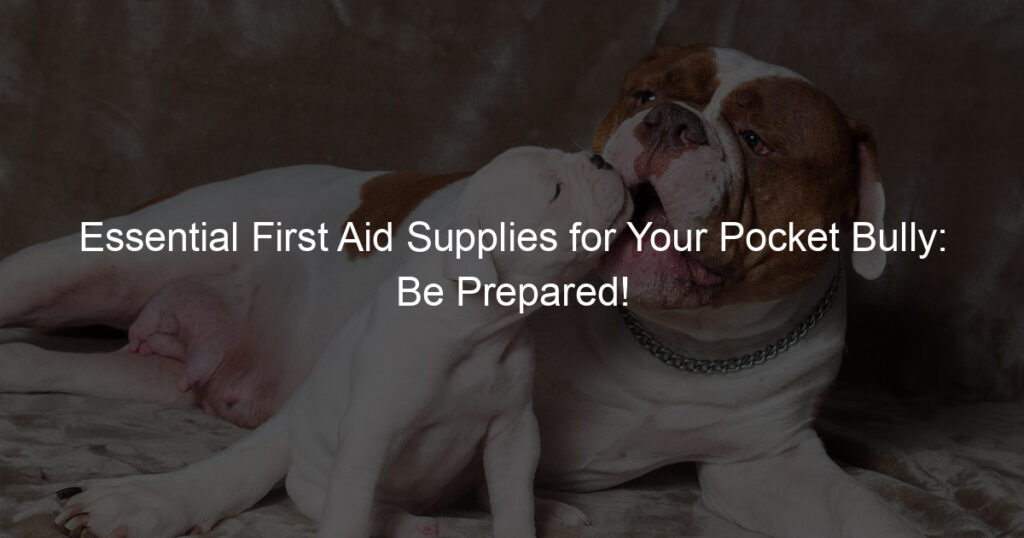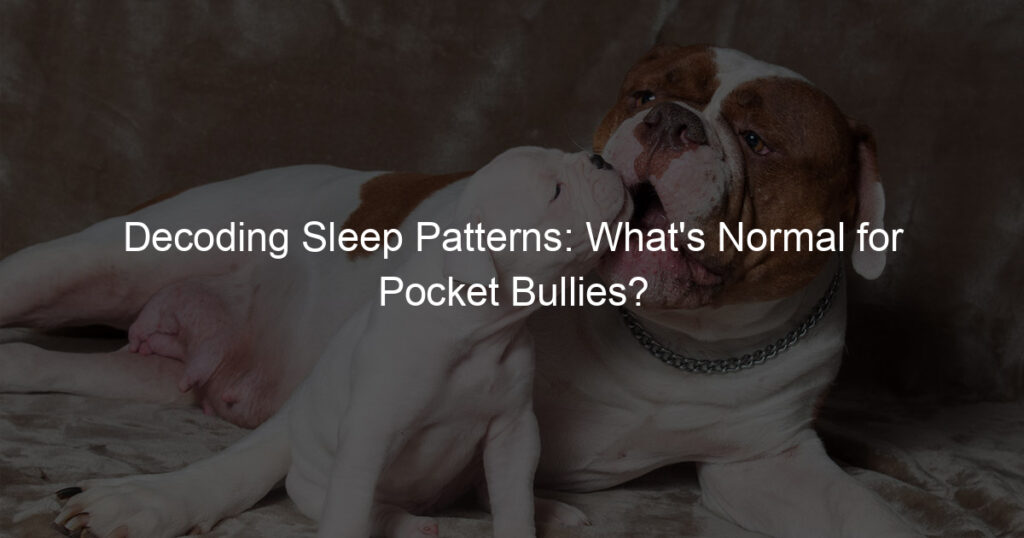
Introduction to Pocket Bullies Behavior
When it comes to understanding the behavior of Pocket Bullies, it’s crucial to remember that every dog breed has unique characteristics that set them apart. Pocket Bullies, a type of American Bully, are no exception. They are known for their compact size, muscular build, and friendly demeanor. However, to truly comprehend their behavior, we must delve deeper into their distinctive traits and the importance of understanding their behavior.
- Understanding the unique characteristics of Pocket Bullies
- Importance of understanding Pocket Bullies behavior
Pocket Bullies are a small, compact version of the American Bully, standing no taller than 17 inches. Despite their small size, they are robust and muscular, displaying a surprising amount of strength and agility. They have a friendly and outgoing personality, making them excellent companions. However, they can be stubborn at times, which is why consistent training from a young age is crucial.
One of the most distinctive characteristics of Pocket Bullies is their loyalty. They are incredibly devoted to their families and will do anything to protect them. They are also known for their intelligence, which makes them quick learners. However, their intelligence also means they can be a bit mischievous, often finding clever ways to get what they want.
Understanding the behavior of Pocket Bullies is essential for several reasons. Firstly, it allows you to provide the right training and socialization, which is crucial for their development. Secondly, it helps you understand their needs and preferences, ensuring they live a happy and healthy life.
Moreover, understanding their behavior can also prevent potential issues. For instance, Pocket Bullies are known for their stubbornness. If not properly trained, this stubbornness can lead to behavioral issues. However, with the right understanding and approach, you can turn this stubbornness into a positive trait, using it to teach them new tricks and commands.
In conclusion, understanding the behavior of Pocket Bullies is not just about knowing their unique traits. It’s about understanding their needs, preferences, and potential issues. By doing so, you can ensure they live a happy, healthy, and fulfilling life.
Understanding Pocket Bullies Body Language
One of the most fascinating aspects of owning a Pocket Bully is learning to understand their body language. Dogs, including Pocket Bullies, communicate primarily through body signals. By learning to interpret these signals, you can strengthen your bond with your pet and better meet their needs.
Reading Pocket Bullies Body Language
Reading your Pocket Bully’s body language involves paying close attention to their facial expressions, body postures, and tail movements. Let’s delve into some of the key signals and signs to watch out for.
- Interpreting Pocket Bullies signals
- Pocket Bullies body language signs
Pocket Bullies, like all dogs, use a variety of signals to communicate their feelings and intentions. For instance, a relaxed and content Pocket Bully may have loose, wagging tail and a soft, open mouth. On the other hand, a stiff body, pinned ears, and a tucked tail can indicate fear or stress. It’s important to remember that context is key when interpreting these signals. The same signal can mean different things in different situations.
There are several specific body language signs that are common in Pocket Bullies. These include:
| Sign | Meaning |
|---|---|
| Wagging tail | Excitement, happiness |
| Pinned ears | Fear, anxiety |
| Stiff body | Stress, fear |
| Relaxed, open mouth | Contentment, relaxation |
Remember, these are general guidelines. Each Pocket Bully is unique and may express themselves in slightly different ways. The key is to spend time with your pet and learn to understand their individual signals.
Understanding your Pocket Bully’s body language is a rewarding and important part of pet ownership. It can strengthen your bond and help you provide the best possible care for your furry friend.
Pocket Bullies Non-Verbal Communication
Non-verbal communication is a significant aspect of understanding your Pocket Bullies behavior. It involves a variety of signals and cues that your dog uses to express its feelings, intentions, and reactions. Let’s delve deeper into this topic.
- Understanding the different forms of Pocket Bullies non-verbal communication
- Examples of Pocket Bullies non-verbal cues
Pocket Bullies, like other dogs, use a range of non-verbal cues to communicate. These can be broadly categorized into three types: body language, vocal sounds, and facial expressions.
Body Language: This is the most common form of non-verbal communication in Pocket Bullies. It includes tail wagging, body posture, and movements. For instance, a relaxed body posture and a wagging tail usually indicate that your Pocket Bully is happy and comfortable.
Vocal Sounds: Although not entirely non-verbal, vocal sounds like barking, growling, or whining are essential cues to understand your Pocket Bully’s mood and intentions. A low growl, for example, might be a warning sign, while a high-pitched bark could indicate excitement.
Facial Expressions: Pocket Bullies also use facial expressions to communicate. Raised ears, for example, can indicate alertness, while averted eyes might suggest submission or fear.
Let’s look at some specific examples of non-verbal cues in Pocket Bullies:
| Non-Verbal Cue | Meaning |
|---|---|
| Tail wagging | Excitement, happiness |
| Low growl | Warning, discomfort |
| Raised ears | Alertness, interest |
| Averted eyes | Submission, fear |
Remember, these are just general guidelines. Each Pocket Bully is unique and may have its own set of non-verbal cues. The key is to spend time with your dog and observe its behavior closely. This will allow you to understand its specific non-verbal language and respond appropriately.
In conclusion, understanding your Pocket Bully’s non-verbal communication can significantly enhance your relationship with your dog. It allows you to understand its needs, feelings, and intentions better, leading to a happier and healthier dog.
Pocket Bullies Behavior Patterns
Understanding the behavior patterns of your Pocket Bullies can help you better communicate with them and meet their needs. Let’s delve into the common behavior patterns seen in Pocket Bullies.
Common Behavior Patterns in Pocket Bullies
Every Pocket Bullies has its unique personality, but there are some common behavior patterns that many of them share. Recognizing these patterns can help you understand your pet better.
- Identifying common behavior patterns in Pocket Bullies
- Playfulness: Pocket Bullies are known for their playful and energetic nature. They love to play fetch and can keep themselves entertained with their toys for hours.
- Loyalty: Pocket Bullies are incredibly loyal to their owners. They are known to follow their owners around and prefer to stay close to them.
- Protectiveness: Pocket Bullies are protective of their families. They are known to be wary of strangers and can act as excellent guard dogs.
- What these behavior patterns reveal about your Pocket Bullies
- Playfulness: This behavior shows that your Pocket Bullies are happy and healthy. It also indicates that they require regular exercise to stay fit and content.
- Loyalty: This behavior indicates that your Pocket Bullies have formed a strong bond with you. They see you as their pack leader and will look to you for guidance.
- Protectiveness: This behavior suggests that your Pocket Bullies are instinctively protective. They view their home as their territory and will do their best to guard it.
Some common behavior patterns in Pocket Bullies include:
These behavior patterns can tell you a lot about your Pocket Bullies:
Understanding these behavior patterns can help you provide the best care for your Pocket Bullies. Remember, every dog is unique, and these are just general patterns. Your Pocket Bullies may display other behaviors that are unique to them.
Unusual Behavior Patterns in Pocket Bullies
While Pocket Bullies are known for their playful and friendly nature, they can sometimes exhibit unusual behavior patterns. These behaviors can be a sign of various issues, ranging from health problems to emotional distress. It’s crucial to identify and understand these unusual patterns to ensure your Pocket Bully’s well-being.
- Identifying unusual behavior patterns in Pocket Bullies
- Excessive aggression: While Pocket Bullies can be protective, excessive aggression towards other animals or people is not normal.
- Constant hiding: If your Pocket Bully is always hiding or avoiding interaction, it could be a sign of fear or anxiety.
- Excessive barking or whining: This could indicate discomfort, pain, or distress.
- Changes in eating or sleeping habits: A sudden change in appetite or sleep patterns could be a sign of health issues.
- What these unusual behavior patterns could mean
Unusual behavior patterns in Pocket Bullies can manifest in various ways. Some of the most common include:
Unusual behavior patterns in Pocket Bullies can indicate various issues. Here’s what they could mean:
| Behavior | Possible Meaning |
|---|---|
| Excessive aggression | Sign of fear, territorial behavior, or lack of socialization |
| Constant hiding | Sign of fear, anxiety, or past trauma |
| Excessive barking or whining | Sign of discomfort, pain, or distress |
| Changes in eating or sleeping habits | Sign of health issues such as digestive problems or insomnia |
Remember, these are just possible meanings. If your Pocket Bully is showing any unusual behavior, it’s best to consult with a veterinarian to rule out any health issues. It’s also important to consider your pet’s environment and recent experiences, as changes can trigger unusual behaviors.
In conclusion, understanding your Pocket Bully’s behavior is essential to ensure their happiness and well-being. Always pay attention to any changes in their behavior and seek professional help when necessary.
Learning from Pocket Bullies Behavior
Understanding the behavior of Pocket Bullies is crucial for their proper care and training. By observing their actions and reactions, we can gain valuable insights into their mental state and emotional well-being. Let’s delve into two case studies that highlight different aspects of Pocket Bullies behavior.
Case Studies on Pocket Bullies Behavior
- Case study 1: Understanding aggressive behavior in Pocket Bullies
- Case study 2: Understanding submissive behavior in Pocket Bullies
In this case, a Pocket Bully named Max was observed for a period of six months. Max was known for his aggressive behavior, especially towards strangers. Through careful observation and analysis, it was found that Max’s aggression was primarily a result of fear and insecurity. He was not naturally aggressive but was reacting to perceived threats. This case study underscores the importance of understanding the underlying causes of aggressive behavior in Pocket Bullies.
In another case, a Pocket Bully named Bella was studied. Bella was extremely submissive, often avoiding interaction with other dogs and humans. Upon investigation, it was discovered that Bella’s submissive behavior was a result of previous traumatic experiences. This case study highlights the impact of past experiences on a Pocket Bully’s behavior and the importance of providing a safe and nurturing environment for them.
These case studies illustrate that Pocket Bullies, like all dogs, have complex emotional lives and their behavior is often a reflection of their internal state. By understanding their behavior, we can better cater to their needs and foster a stronger bond with them.
Key Takeaways from Understanding Pocket Bullies Body Language
As we delve deeper into the world of Pocket Bullies, it’s crucial to understand their body language. This knowledge can greatly enhance our relationship with these adorable creatures. Here are the key takeaways:
- Importance of understanding your Pocket Bullies body language
- How understanding your Pocket Bullies body language can improve your relationship with them
Understanding your Pocket Bullies body language is of utmost importance. It’s like learning a new language, but instead of words, you’re interpreting wagging tails, perked ears, and other physical cues. These signals can tell you if your dog is happy, scared, or even unwell.
For instance, a wagging tail doesn’t always mean a happy dog. Sometimes, it can indicate fear or anxiety. Similarly, if your Pocket Bully is licking its lips, yawning, or showing the whites of its eyes, it could be a sign of stress. By understanding these cues, you can respond appropriately and ensure your pet’s well-being.
Understanding your Pocket Bullies body language not only helps you cater to their needs but also strengthens your bond with them. It’s like having a secret language that only you and your pet understand.
For example, if your Pocket Bully often turns its head away when you try to pet it, it might be uncomfortable with the interaction. Respecting this signal and giving your pet some space can help build trust and make your relationship stronger.
Moreover, by understanding your Pocket Bully’s body language, you can also train them more effectively. For instance, if your pet seems distracted or stressed during a training session, it might be best to take a break and try again later.
In conclusion, understanding your Pocket Bullies body language is a vital part of pet ownership. It allows you to understand their needs, emotions, and health, leading to a happier and healthier pet. So, take the time to observe and learn from your Pocket Bully’s body language. It’s a language that speaks louder than words.
Conclusion: Decoding the Body Language of Pocket Bullies
As we conclude this insightful journey into understanding the body language of Pocket Bullies, let’s summarize the key points we’ve discussed and reflect on the importance of this knowledge.
- Summary of key points discussed in the article
- Final thoughts on the importance of understanding Pocket Bullies body language
Throughout this article, we’ve delved into the fascinating world of Pocket Bullies, a breed known for its unique behavior and expressive body language. We started by introducing you to the typical behavior of Pocket Bullies, highlighting their playful, energetic, and sometimes assertive nature.
We then moved on to understanding their body language, where we learned that their tail wagging, ear positioning, and body posture can tell us a lot about their mood and intentions. We also discussed common behavior patterns, such as their tendency to show affection through licking and their assertiveness when protecting their territory.
Finally, we emphasized the importance of learning from these behaviors to build a strong and healthy relationship with your Pocket Bully. Observing and understanding their body language can significantly enhance your communication with them, leading to a happier and more harmonious coexistence.
Understanding the body language of Pocket Bullies is not just about decoding their actions; it’s about building a bridge of communication between you and your furry friend. It allows you to respond to their needs more effectively, ensuring their well-being and happiness.
Moreover, by understanding their body language, you can prevent potential misunderstandings that could lead to behavioral issues. It’s a tool that empowers you to nurture a positive and respectful relationship with your Pocket Bully, contributing to their overall development and well-being.
In conclusion, the body language of Pocket Bullies is a language of its own, filled with nuances and subtleties. By learning to decode it, you’re not only becoming a better pet parent but also enriching the bond you share with your Pocket Bully. Remember, every wag, lick, and posture has a story to tell. So, keep observing, keep learning, and keep loving your Pocket Bully.














